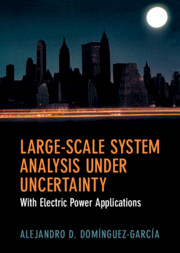Refine search
Actions for selected content:
3 results
1 - Introduction
-
- Book:
- Large-Scale System Analysis Under Uncertainty
- Published online:
- 17 January 2022
- Print publication:
- 17 February 2022, pp 1-15
-
- Chapter
- Export citation
4 - Static Systems: Probabilistic Structural Uncertainty
-
- Book:
- Large-Scale System Analysis Under Uncertainty
- Published online:
- 17 January 2022
- Print publication:
- 17 February 2022, pp 91-129
-
- Chapter
- Export citation

Large-Scale System Analysis Under Uncertainty
- With Electric Power Applications
-
- Published online:
- 17 January 2022
- Print publication:
- 17 February 2022
